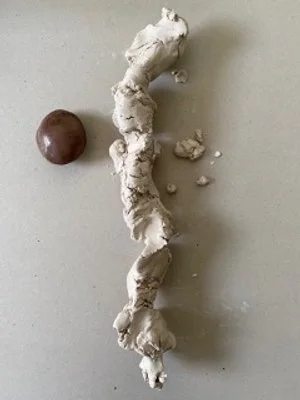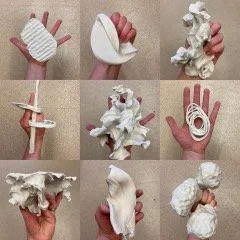An Espresso with Sarah Christie: Cross-disciplinary Artist on Clay, Collaboration and overcoming Challenges
Sarah Christie is a UK-based cross-disciplinary artist whose sculptural practice centres on collaboration, material exploration, and the reciprocal relationships that sustain creative work. Working primarily with clay, Christie creates three-dimensional forms that emerge from an ongoing dialogue between solo studio practice and collaborative making. Christie's work has evolved from an initially solitary focus on clay to embrace a more fluid, cross-disciplinary approach that includes drawing, writing, and collaborative projects. Her "Sensing" series and "Instrumental Objects" demonstrate how sculpture can be both deeply personal and enriched by exchange with other artists and audiences. In this conversation, Sarah discusses how success means working with people who sustain you, how her practice has evolved to embrace multiple materials and collaborative approaches, and the challenges of maintaining creative momentum through life's inevitable interruptions. Below is our conversation, part of my series 'An Espresso with...'. Sarah Christie is an Associate Lecturer at Central Saint Martin, part of the University of the Arts London, and a member of the Royal Society of Sculptors.
Defining Success Through Collaboration
What’s success for you?
In a way, success is about working with interesting people who sustain you, and you sustain them in return. This reciprocal way of working has become more important to me than producing objects. It’s still productive, but in a different way. One of the most rewarding and exciting aspects of a collaboration is the enriching experience of exchange and connection with other artists and audiences. Exchange works both ways and opens up new experiences and insights that you might not reach alone. It’s also a way of challenging what you think you already know, and so, at its best, expands horizons and possibilities for making. If it works well, it can be a supportive environment in which you learn from one another and develop your practice in unexpected ways. Ultimately, it feels like success if I stay interested and get to sustain that practice just enough.
Evolution from Clay to Cross-Disciplinary Practice
How has your work evolved in the last few years?
I think I have swum quite far out to sea from where I was at the beginning. Initially, I worked with clay, thinking that working is quite a solitary practice that I will maintain on my own, as it will be about process and making work. It’s still true, but recently I have allowed myself to be free about what materials and processes I am going to use, and to be curious, follow my nose a little bit, and find those materials and medium that suit what I want to do rather than assume it’s going to be clay. Although my practice is sculptural and three-dimensional at its core, sometimes there is an opportunity to think about it differently, like through drawing and writing. I also believe that we are stronger and can do more in collaboration than on our own. It’s tempting to think that it all happens on your own in your studio, and some does, but not everything happens in that way. My tendency is to do too many things on any possible level in life, and I have given myself permission to work in that direction in my practice as well. But I am conscious of not ending up in a kind of chaos, as it is easy to muddy everything up. At the moment, I am finding it quite fruitful and freeing to apply different approaches to my work.
Overcoming Challenges and Creative Interruptions
What difficulties have you encountered as an artist, and how have you managed to overcome them?
There are different levels of difficulty. There are the day-to-day difficulties that are taking up quite a lot of time and energy, and everybody experiences them at some level. Then there are the biggest things, which on paper are legitimate difficulties, and over the years, they will influence your practice. When you have one or two years when you aren’t very productive and need time out, it’s challenging to re-enter because you can lose the thread of where you were. When that happens to me, I start to lose confidence in what I am doing and start to have doubts. It turns an interruption into something that you have to overcome, but ‘there is no around, only through’. Collaborative practices can be helpful because sometimes the opportunity to collaborate with other people is an effective way of lifting yourself, as you know that they also have their challenges and difficulties. Suddenly, it doesn’t feel like you are alone climbing a mountain.
Reflections on This Conversation
Speaking with Sarah revealed how collaborative practice can be a lifeline for artists, particularly during periods of doubt or interruption. Her evolution from working solely with clay to embracing multiple materials and collaborative approaches demonstrates how permitting oneself to explore can lead to unexpected creative freedom.
Three key insights:
Success is about reciprocal relationships, working with people who sustain you while you sustain them in return, creating exchanges that open up new experiences and insights
Evolution requires balancing curiosity and coherence, permitting yourself to explore different materials and processes while remaining conscious of not creating chaos
Collaborative practice helps overcome isolation, knowing that others face similar challenges transforms the experience from climbing a mountain alone to being part of a supportive community
Learn more about Sarah Christie's work at www.sarahchristie.net
From ongoing ‘Sensing’ series, porcelain and terracotta
'Instrumental Objects', porcelain
If you enjoyed this conversation, you might also like :
‘Yoshitomo Nara’s Lessons in Clay’ interview published on Elephant magazine
Rana Begum interview in Printmaking Today
"An Espresso with..." interviews with female artists
Explore more interviews and reviews in my Portfolio, or subscribe to receive new interviews
An Espresso With…
This project is supported by




